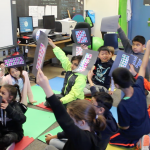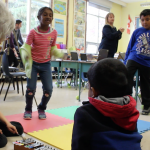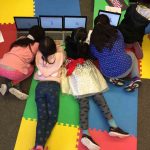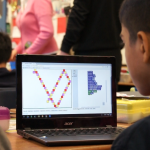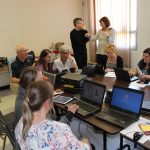Earlier this year, George Gadanidis (University of Western Ontario) invited us to collaboratively pilot a series of coding and computational thinking lessons with teachers and children in Kindergarten to Grade 6 classrooms with St. Andrews Public School (Toronto District School Board).
The lessons were designed by George Gadanidis and featured arts-based approaches to coding. For example, in Kindergarten and Grade 1, we began by inviting children to design colour patterns using bingo dabbers on strips of grid paper. Next, students “played the patterns” on pentatonic xylophones with each note assigned a specific colour. Children then invited classmates to “dance” the patterns and codes on coloured mats that coordinated with the colour-coordinated xylophone keys.
- Children create non-digital codes with colour patterns.
- Children play the codes on xylophones.
- Children dance the codes on colour-coordinated mats.
- Children program computers to animate their patterns.
- A student watches his code come to life.
- Educators meet after the lesson to discuss how the lesson can move forward.
Students then used a computer program designed by Gadanidis and team to create digital codes to represent their patterning work. Students were highly engaged in these coding “unplugged” and digital coding activities, and teachers were amazed at the number sense their students were demonstrating. During our debrief sessions following each day’s lessons, teachers had the opportunity to share insights on student learning.
Have a look at the two-minute video above to see examples of children coding and then explaining what the codes mean. We were especially impressed with the way in which children can explain what the codes mean numerically and structurally. Coding also seems to help children articulate an understanding of a pattern core and the structure of a grid.

